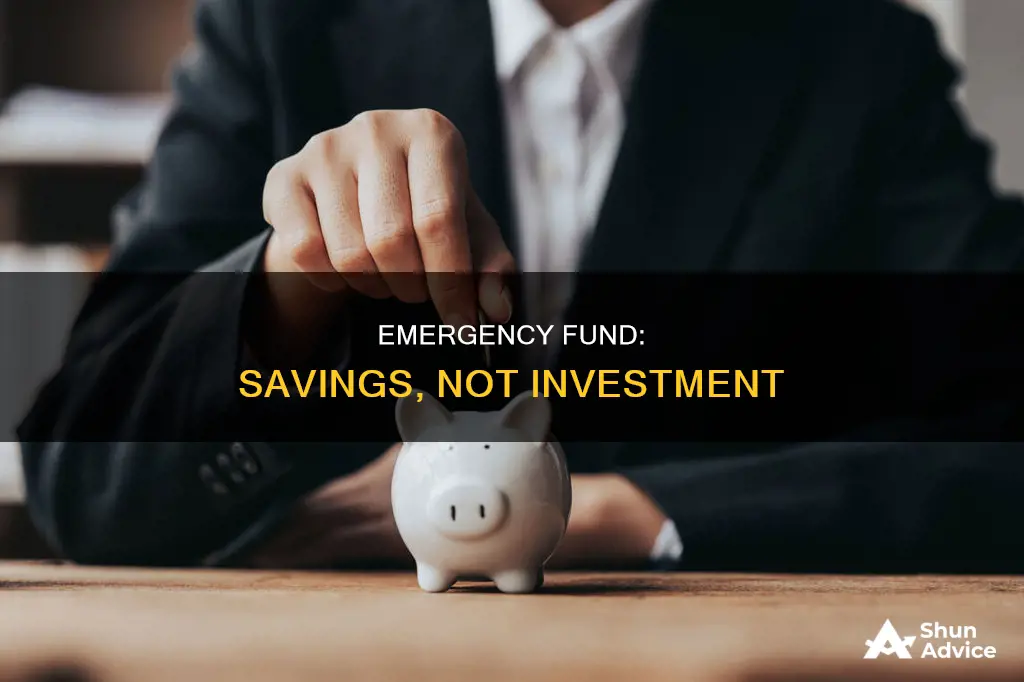
An emergency fund is a crucial financial safety net, designed to cover unexpected costs such as medical bills, home repairs, or unemployment. While investing this money might seem appealing, it is generally not recommended. Here's why: the primary purpose of an emergency fund is to provide quick access to funds during financial crises. Investing these funds in stocks, real estate, or other volatile assets could result in losses if you need to liquidate them urgently. Additionally, certain investments, like retirement funds, may have withdrawal restrictions and penalties. Keeping your emergency fund in a savings account ensures accessibility and preserves your initial deposit. While a savings account may not offer high returns, it guarantees the availability of funds when you need them the most.
| Characteristics | Values |
|---|---|
| Accessibility | Emergency funds should be easily accessible to cover unexpected expenses. |
| Risk | Investing emergency funds in volatile assets like stocks could lead to losses if you're forced to sell at the wrong time. |
| Liquidity | Emergency funds should be kept in liquid assets to ensure quick conversion to cash without penalties. |
| Opportunity Cost | Keeping emergency funds in a savings account preserves your initial deposit, even if it means foregoing potential investment gains. |
| Taxes | Withdrawing money from a taxable brokerage account triggers tax payments, which could further deplete your emergency funds. |
What You'll Learn
- Emergency funds are needed to cover unexpected costs, and investments may not be easily accessible
- The purpose of an emergency fund is to have money readily available, and investments may decrease in value
- You may be forced to sell investments at a loss to cover emergency expenses
- Emergency funds are recommended to be kept in savings accounts, which are more stable than investments
- Investments may be subject to taxes when withdrawn, reducing the total amount available for emergencies

Emergency funds are needed to cover unexpected costs, and investments may not be easily accessible
Emergency funds are an essential part of financial planning, but they should not be considered an investment. The primary purpose of an emergency fund is to cover unexpected costs and provide financial security during challenging times. Here's why emergency funds need to be easily accessible and why they should be kept separate from investments:
Unexpected Costs and Financial Security
Emergency funds serve as a safety net to cover unforeseen expenses, such as medical bills, car repairs, home appliance breakdowns, or even periods of unemployment. These financial shocks can occur at any time, and having a dedicated fund ensures you're prepared. Without an emergency fund, you may be forced to rely on credit cards or loans, leading to debt and higher interest rates. A good rule of thumb is to save enough to cover three to six months' worth of living expenses.
Accessibility and Liquidity
The key advantage of an emergency fund is its accessibility. When faced with an unexpected expense, you need immediate access to your funds. Keeping your emergency fund in a savings account ensures you can quickly withdraw money without penalties. Investments, on the other hand, may not be as liquid, and selling assets to access cash can take time and result in losses. Emergency funds should be readily available to provide peace of mind during stressful situations.
Risk of Investment Losses
Investing your emergency fund in the stock market or other high-risk ventures exposes you to potential losses. The value of your investments can decrease, leaving you with less money when you need it the most. The goal of an emergency fund is to safeguard your finances, not gamble with potential gains. While it may be tempting to seek higher returns, the priority should be stability and liquidity.
Separate Savings and Investments
It's essential to maintain a clear distinction between your savings and investments. Your emergency fund should be kept in a dedicated savings account, separate from your retirement or investment funds. This separation ensures that your emergency funds are easily accessible and insulated from market volatility. By keeping your emergency fund in a high-yield savings account, you can earn interest on your savings while maintaining liquidity.
In summary, emergency funds serve a specific purpose: to provide financial security and accessibility during unexpected events. Investing your emergency fund defeats this purpose by introducing risk and reducing liquidity. Keep your emergency funds separate from your investments, and focus on building a stable and readily available source of funds for unforeseen circumstances.
Baillie Gifford Fund: Where Should Your Money Go?
You may want to see also

The purpose of an emergency fund is to have money readily available, and investments may decrease in value
An emergency fund is a safety net to protect you from life's unexpected costs, such as medical bills, car repairs, or a loss of income. It is recommended to have three to six months' worth of living expenses in an emergency fund, which can be a challenge to build up. So, it can be tempting to invest this money to try to grow it faster. However, doing so is risky and not advisable.
Additionally, investments are often illiquid, meaning it can take time to access your money. For example, if you invest in real estate, it can take time to sell the property and convert it into cash. Even with more liquid investments, such as stocks, it can take several days to sell and access the funds. In an emergency, you want to be able to access your money quickly and easily.
Another reason to avoid investing your emergency fund is the potential tax consequences. When you sell investments and realise gains, you will owe taxes on those profits. If you have held the investments for less than a year, you will likely pay a higher tax rate than if you had held them for longer. In an emergency, you may be forced to sell your investments sooner than planned, resulting in a higher tax bill.
Instead of investing your emergency fund, consider keeping it in a high-yield savings account. This allows you to earn interest on your money while keeping it safe and accessible. High-yield savings accounts typically offer competitive interest rates, and your deposits will be insured by the FDIC up to $250,000 per eligible account. You can easily withdraw money from these accounts when needed, and there are often no fees or minimum balance requirements.
In summary, investing your emergency fund may seem appealing, but it is risky. The purpose of an emergency fund is to have money readily available, and investments may decrease in value or be difficult to access when needed. By keeping your emergency fund in a high-yield savings account, you can earn interest while ensuring your money is safe, accessible, and ready for unexpected expenses.
Unlocking Opportunities: Investing in VC Funds
You may want to see also

You may be forced to sell investments at a loss to cover emergency expenses
An emergency fund should be easily accessible so that you can use it to cover unexpected expenses. However, if you invest your emergency fund in stocks or other volatile assets, you may be forced to sell at a loss when you need the money.
For example, let's say you invest your emergency fund in the stock market and the value of your stocks decreases. If you then have an unexpected expense, such as a medical bill or car repair, you may be forced to sell your stocks at a loss to cover the cost. This could leave you with less money than you originally invested and could put you in a difficult financial position.
Similarly, if you invest your emergency fund in real estate or other non-liquid assets, it may take time to access the cash. You may not be able to sell these assets quickly enough to pay for an emergency expense, and you may incur penalties or fees for early withdrawal.
To avoid this risk, it is generally recommended that you keep your emergency fund in a savings account or other low-risk, liquid investment. This way, you can be sure that your money will be easily accessible when you need it and you won't have to worry about selling at a loss.
While investing your emergency fund may seem tempting, especially with the threat of inflation, it is important to remember that the primary purpose of an emergency fund is to provide financial security and peace of mind. By keeping your emergency fund in a safe and accessible place, you can ensure that you have the resources to handle unexpected expenses without taking on additional risk.
Best Mutual Funds for Short-Term Investments
You may want to see also

Emergency funds are recommended to be kept in savings accounts, which are more stable than investments
Emergency funds are best kept in savings accounts, which are more stable than investments. Here's why:
Stability and Accessibility
Savings accounts are a stable option for your emergency funds, preserving your initial deposit and ensuring the money is there when you need it. While investments may offer higher returns, they also carry the risk of losing value, leaving you with less money than you invested. Savings accounts provide a safe and accessible place for your emergency funds, allowing you to withdraw money quickly in case of unexpected expenses.
Avoiding Investment Risks
Putting your emergency funds in investments like the stock market or high-risk ventures exposes you to potential losses. The stock market can be volatile, and you might be forced to sell at a loss if you need the money urgently. Other investments, such as real estate or new businesses, may require time to liquidate, making them less than ideal for emergency funds. Keeping your emergency funds in a savings account avoids these risks and provides peace of mind.
Liquidity and Flexibility
Savings accounts offer liquidity and flexibility, allowing you to access your funds without penalties. In contrast, certain investments, like certificates of deposit (CDs), often charge early withdrawal fees if you need to access your money before the term ends. With a savings account, you can easily withdraw funds without incurring additional costs, giving you the flexibility to respond to financial emergencies.
Interest Earnings
While the primary purpose of an emergency fund is accessibility and stability, you can still earn interest on your savings. High-yield savings accounts offer competitive interest rates, allowing your emergency fund to grow over time. This provides a balance between keeping your funds liquid and earning returns, all while avoiding the risks associated with investments.
Protection from Debt
Having an emergency fund in a savings account can help you avoid taking on debt during financial shocks. Without an easily accessible fund, you might rely on credit cards or loans, which can lead to high-interest debt. An emergency fund in a savings account acts as a financial buffer, allowing you to borrow from yourself interest-free and providing protection from debt accumulation.
Mutual Funds: NRIs' Smart Investment Choice
You may want to see also

Investments may be subject to taxes when withdrawn, reducing the total amount available for emergencies
When you invest money into a taxable brokerage account, you will be responsible for paying taxes when you sell shares and realise your gains. The tax rate you will pay depends on when you bought the shares and when you sold them.
Profits made from selling assets you have held for one year or less are subject to a short-term capital gains tax, which will usually be the same as your regular income tax rate. On the other hand, if you sell assets you have kept for over one year, you will pay a long-term capital gains tax, the rate for which is between 0% and 20%. Generally, it is better to be taxed at the long-term capital gains rate since you would typically owe less in taxes. However, emergencies are unpredictable, and you may be forced to sell your assets less than a year after buying them, meaning you will owe more in taxes.
If you invest your emergency fund and then need to withdraw it, you will be taxed on your gains, reducing the total amount available for emergencies.
If you are looking for a way to grow your emergency fund, consider a high-yield savings account. These accounts pay you interest each month for keeping your money in the account. This lets you grow your balance a little quicker even if you are not making regular contributions. For example, Marcus by Goldman Sachs High Yield Online Savings and Ally Online Savings offer 4.50% and 4.20% APY respectively. The APY generally depends on the interest rates set by the Federal Reserve, so it can change and even increase over time.
Retirement Mutual Funds: Choosing the Right Investment for Your Future
You may want to see also
Frequently asked questions
An emergency fund is a safety net to cover you for unexpected expenses such as medical bills, home repairs, or a period of unemployment. It is not an investment because it should be easily accessible and kept in a separate account from your daily expenses.
It is recommended to keep your emergency fund in a savings account, preferably a high-yield savings account, to earn a competitive interest rate while keeping your money safe and easily accessible.
Investing an emergency fund in stocks, index funds, or other high-risk investments could potentially decrease its value before you need to use it. You may also face difficulties in accessing your money quickly, especially if it is tied up in a long-term investment fund or retirement account.







